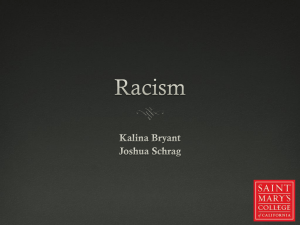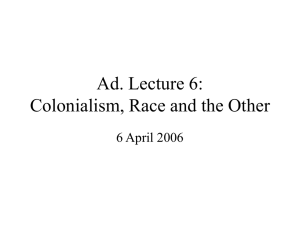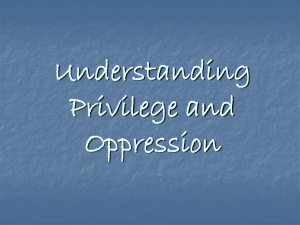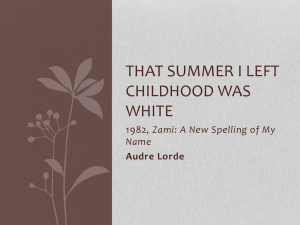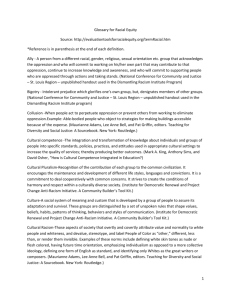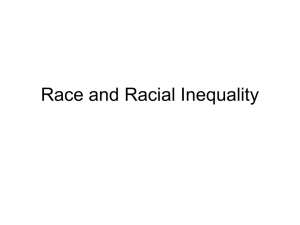Multicultural Therapy
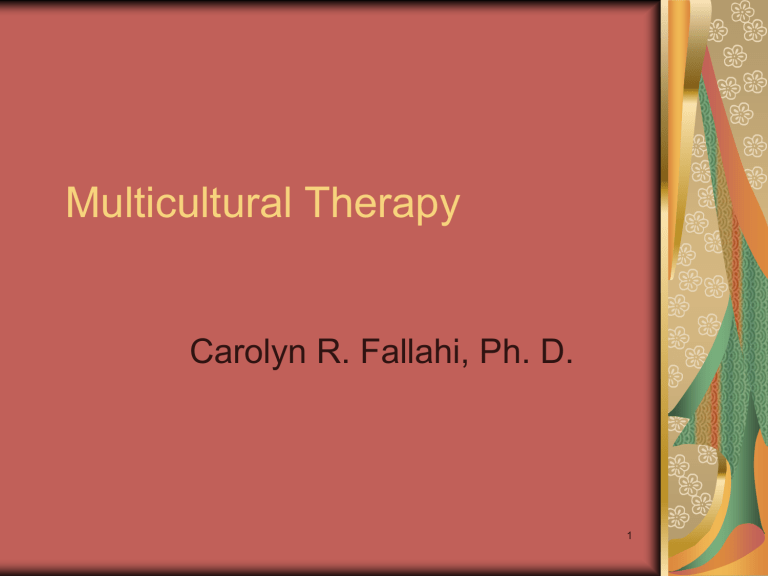
Multicultural Therapy
Carolyn R. Fallahi, Ph. D.
1
The need for cultural competence
There is a need for cultural competence within therapy.
Traditional approaches have failed to meet the needs of minorities.
A large percentage of the population of the United States is composed of people whose racial/ethnic background is something other than white.
2
Minority Groups
Most minority groups are:
Without underrepresented in traditional clinical/counseling populations.
There aren’t a lot of faculty members who are minorities.
Racial & Gender domination perpetuates these issues.
Mostly white, middle-class males who are the teachers & administrators.
3
What do we see with minority patients?
More negative psychiatric diagnoses.
Substandard treatment.
Inferior & differential counseling services for differing racial & ethnic patients.
Underutilization of mental health services. Why? Lack of minority therapists?
4
What are the issues with multicultural therapy?
Lack of attention & emphasis on social injustices & problems encountered by minorities.
Sue & Smith: underrepresentation of minority groups in professional counseling training programs reinforces the perception that therapy is generally irrelevant to their needs.
5
Recurring Issue
Discomfort of White Therapist working with someone different from them.
This plays out in:
Negative stereotyping.
Lack of knowledge about the group of which the patient is a member.
Generalized anxiety about working with different populations.
Need: major reform in graduate programs.
6
Multicultural Education Models
Are we creating an environment in which we can foster cross-cultural awareness & understanding?
Theories exposed to are monocultural.
No research in the area of cross-cultural awareness development.
Theoretical models imply that psychosocial development is uniform for all members of society, regardless of cultural or racial background.
7
Why aren’t these theories enough?
Sociopolitical factors such as SES, class, & power are largely ignored.
Selected variables of the authors’ culture, such as individualism are emphasized.
Many variables have limited applicability in pluralistic societies.
8
What do the contemporary White
Western Theories & Models emphasize?
Tendency to assume that psychosocial development occurs in a similarly orderly & uninterrupted progression for all.
Ethnic & racial awareness & identity have not been considered noteworthy or integral within psychosocial development process.
9
Contemporary White Models
Cultural biases & taboos of a given author’s society, including those relating to racism, prejudice, and discrimination have been built into the theories.
Members of society who do not represent the dominant culture find that the models do not “fit” their life experiences.
Theories of deviance, deprivation, disadvantage, and abnormality are based on the experiences of various groups & how they differ from the model.
10
Contemporary White Models
The research has incorporated biases inherent in monocultural theoretical models.
11
Multicultural Research
High-status & low-status group – how do individuals become aware of this?
Psychosocial development of minority groups. This new research is beginning to take sociopolitical factors into account.
Quest for self-identity.
12
Oppression
Oppression is a common approach.
Uncomfortable & “radical framework” for some.
Dominant force.
Less familiar to therapists, both cognitively & experimentally.
Oppression, as a common experience, is the approach that provides a schema to the experiences of Asians, Latinos,
African Americans, etc.
13
Cross-cultural Training Models
Need to emphasize:
Competency: requires that the therapist be culturally aware, in touch with his/her own biases about minority patients, comfortable with such differences, & sensitive to circumstances that may require the referral to circumstances that may require referral to same-culture therapist.
14
Cross-cultural Training Models
Second competency area: command of knowledge, such as information sets, that the culturally skilled therapist should have.
Understanding of the effects that the sociopolitical system within the U.S. has an oppressed persons, culture specific knowledge about the particular group being counseled, an understanding of the institutional barriers to the use of mental health services by nondominant groups.
15
Future Clinicians
Gain knowledge of specific minority groups.
Focus on concerns such as value changes, acculturation, generational differences, parental pressures, dating, & religious issues.
Supervision on these issues.
16
Third Competency
Therapeutic skills: should have a wide repertoire of verbal & nonverbal responses, the ability to send messages accurately & appropriately, and the ability to use appropriate institution intervention.
Assume a universalist approach or a culture-specific approach? This is a controversy that has not yet been settled.
17
The distinction between cultural & individual differences.
A person should be seen as an individual & as a member of his/her own cultural group.
Locke: you need to take into account the differences within a person’s culture in the context of the dominant culture.
Each culture is both dynamic & subjective,
& his training stresses “learning to work in different cultures rather than merely learning about cultures”.
18
Therapists trained from the Euro-
North American cultural belief system
Value self-disclosure, highly verbal, & goaloriented patients.
Issues of self-disclosure? How we interpret selfdisclosure or lack there of …. Need to take background into account.
Does the patient feel safe to share?
If the therapist doesn’t see self-disclosure, consider it resistant & nonproductive?
19
Other Issues
Lack of role models in terms of therapists, faculty, & administrators, the traditional white majority student population attending programs will continue.
Traditionally: therapy has been willing to accept culturally different people if they are willing to become acculturated and reject their cultural distinctiveness.
Some of the negative programs based on the melting pot philosophy.
20
A strong conceptual framework
Sociopolitical ramifications of therapy:
Oppression
Discrimination
Racism
****Programs have to help trainees become aware of themselves as cultural beings.
The culturally different patient becomes the object to be analyzed & studied.
Focus on the stereotypes of the therapist.
21
Barriers to effective multicultural counseling instruction
Melting pot myth
Incongruent student expectations about therapy
Overemphasis on verbal disclosure
Overemphasis on abstract
& non-problem-solving strategies.
Ethnocentric worldview
Ignorance of self-racism & cultural identity of others
Monolingual orientation
Overemphasis on longrange goals & the future.
Lack of understanding of the whole person
Lack of understanding of social focus
Lack of appreciation for nonverbal communication
22
Emphasize
Culture
Race
Ethnicity
Dominant culture
Bi-culturalism
Melting pot myth
Pluarlism
Oppression
Cultural invasion
Issues relating to power & internalized racism
Marginality
Lived experiences & contradictions
23
Becoming Culturally Competent
Ethnocentricity: a major obstacle to becoming culturally competent.
Relatively few US scholars cite international journals.
Only 60% US Scientists feel that being connected to international scholars is important.
24
Becoming Culturally Competent
Xenophobia: unreasonable fear, distrust, hatred of strangers or foreigners or anything perceived as different.
Difficulty accepting others’ worldviews.
Accepting differences across cultures as simply differences.
Universality assumptions.
25
Becoming Culturally Competent
Personality styles.
Reality is defined according to one’s cultural assumptions. People become insensitive to cultural variations among individuals & assume that their own view is the only right one.
So????? How do we increase global competence & collaboration?
26
Enhance Cross-Cultural Awareness
& Knowledge
Increase our awareness & knowledge on a number of cross-cultural issues.
Encourage study-abroad programs.
Cultural immersion program.
Require coursework.
Require competency in a second language.
Integrate cross-cultural issues & knowledge in our therapy curriculum.
27
Enhance Competency
Promote cross-cultural research & supervision & consultation.
28
Addressing Racism: Derald Wing
Sue
Why do we hold prejudices or stereotypes?
Need to understand our world
Too much information – need to categorize
Makes us feel better about ourselves
29
John Duckitt – History of
Psychology & Prejudice
Prior to the 1920s – notion of race inferiority & white superiority.
Race theories dominated psychological thinking.
Black inferiority was thought of as due to evolution or genetics.
Seen as intellectually inferior.
Prejudice was seen as a natural response to “inferior” races.
30
1920s- 1930s
In the 1920s, empirical data did not settle the controversy over African
Americans.
Movement switched to: where those preconceived attitudes came from.
31
1930s & 1940s
Psychodynamic explanation – prejudice & discrimination was not right.
Irrational & unjustified.
Why so prevalent?
Defense mechanisms.
Same explanation applied to the rise of
Nazism & anti-Semitism in Germany.
32
1950s
The prejudiced personality
Holocaust & massive genocide
Demented disturbed personality
Pathological personality structure, e.g. authoritarian personality – more prone to prejudice.
33
1960s & 1970s
Movement from the individual to a more sociocultural perspective.
Prejudice could be understood as a social or cultural norm.
Normative approach
Consensus model of race relations, Black/white relations.
Socialization & conformity
Racial integration
Conflict, power, & domination were nearly totally neglected.
34
1980s
Ingroup – outgroup research
The new image of prejudice: inevitable outcome of cognitive categorization.
Realization: we as humans have the potential & propensity for prejudice.
Social & intergroup dynamics add to this.
35
Guthrie & Even the Rat was White
Extraordinary dedication to the field of racism within psychology.
Eugenics: the study of hereditary improvements of human race by controlled selective breeding.
Sterilization
PhysicalAnthropologists & cultural
Anthropologists.
36
The role of psychology
1973: Henry Garrett, past APA president:
Argument against racial integration writing that the Black man ‘s brain “on the average is smaller….less fissured and less complex than the white brain.”
Skull capacity differences among humans.
The issue of IQ.
37
Are you a Racist?
Overt bigotry versus more subtle bigotry.
Prejudice versus discrimination.
People of color make up over 1/3 rd of the population & 45% in our public schools.
2030 & 2050 racial/ethnic minority = numerical majority.
38
The average American
Not aware of race issues.
Minimize the impact of racism.
What’s involved? Fear.
Stereotypes serve the function of making you feel better about yourself or about members of a group.
Cultural genocide.
39
Do you oppress?
Modern or contemporary racism.
Modern racism is unconscious, indirect, subtle, & unintentional.
Failure to help versus conscious desire to hurt.
Dovidio Study
Are these stereotypes harmful?
40
African Americans
Black? African American? Ask.
Issues of poverty.
Less likely to be employed in managerial
& professional jobs.
Black women more likely to complete college degree.
26% poverty for Afr Ams versus 8%for
Whites.
Vast inequities.
41
Issues
Long history of traumatic events including slavery, racism, & history of other individual
& social problems.
Indicators of the cumulative effects of trauma – evidenced in health, income, education, & occupational success.
In a therapeutic situation: develop awareness of how oppressive experiences like racism & discrimination influence helpseeking behaviors & overall psychological functioning.
42
Cook & Wiley (2000)
Afr Ams will share their experiences of oppression in psychotherapy.
Limited knowledge of the history of racism & oppression.
Need increased cultural empathy to validate their experiences.
43
Social relationships & strengths
Religion & spirituality
Need to assess religion & spirituality
Harmony & balance – emphasis on the family, community, & nation versus emphasis on the individual.
Interdependence
Traditional therapy
44
Family Dynamics
48% married-couple families.
45% maintained by single women with no spouse.
Extended kinship networks
The role of the church
Different parental-child systems.
The legacy of broken families continued following slavery
45
Gender Issues
Identity linked to ability to provide for family.
Success related to discrimination.
46
Latinos & Latinas
The link between physical & emotional = Medical services.
High tolerance for psychopathology.
Language barriers, sociocultural factors.
Lack of bilingual & bicultural therapists and a lack of cultural sensitivity.
47
Issues in Therapy
The terms used to identify.
High rates of undereducation.
Misplaced in special education classes, non-college tracks, monolingual teachers, culturally insensitive teachers, low achievement expectations.
Underemployed: 7% unemployed versus 3.4% Whites.
48
Other Issues
Religion
Oppression & racism
Acculturation
Family dynamics
Time orientation
Elderly versus Youth
Family & support system
49
The Dynamics of Therapy
Family – strength & liability.
Great value placed on manners, courtesy, harmonious relationships
Conflict, direct argument, & contradiction considered rude.
Gender roles
Youth
Parent & child relationships
50
Other issues
Religion
Gender & sexual norms
Boys versus girls
Homophobia
Interdependent & cooperative
51
Other Problems
Physical & emotional difficulties of aging.
Cultural alienation
Racial discrimination
Language barriers
Lack of health insurance
Limited financial resources
Different cultural customs & beliefs poverty
52
Native Americans
How do we refer to Native
Americans?
Experiences shared by Native
Americans.
Loss of tribal lands to US Government
Problems with assimilation
General lack of respect for their humanity
Cultural genocide
53
Problem Areas
Life expectancy
High rates of employment
School dropout
Teen pregnancy
Alcoholism
Poverty
54
Therapy Issues
Present orientation to time
Indian time
Noninterference
Direct confrontation
Healing process
Talking circles
55
Educational Concerns
57% obtain a high school degree
English
Low self-esteem
Cultural value differences
Health problems
Chronic poverty
Few positive career models
56
Alcoholism
52-80%
Lower tolerance?
Underuse of mental health services
57
Asian Americans
Family dynamics
Confucius laid the general template for Asian families centuries ago.
A vertical structure
Father at its head
Mother deferential & supportive
Children obedient to and respectful towards both
Family values: duty, work, achievement
Methods used: shame, guilt, appeal to duty, honor
58
Parenting
Children are expected to not embarrass, shame, or dishonor
Authoritarian parenting
Other parenting differences.
Collectivist values of interdependence, conformity & harmony.
Direct confrontations are avoided.
59
Family
Emotional expression considered in bad form.
Love & affection not expressed openly
Indirect communication
Older generation parents & acculturated children
Marriage issues
60
Family
Strong negative stereotypes for marrying a non-Asian.
Interracial marriage = betrayal
61
Therapy Issues
Problems: enmeshment
Codependence
Lack of individuation
Social anxiety
Psychopathological labels
Enormous pressure to excel academically
Parental emphasis on work ethic
62
Therapy Issues
Elderly – revered & respected
Parents’ children expected to fulfill their needs, care for them, treat them with reverence, & obey their wishes & plans.
High rate of suicide.
Unequal treatment of girls & boys
63
Therapy Issues
Conflicts over family
Family responsibility & obligations
Emphasis on autonomy, overt masculinity, & self-reliance (American values)
Gender issues
Homosexual & transgender Asians
How view mental health problems
64


